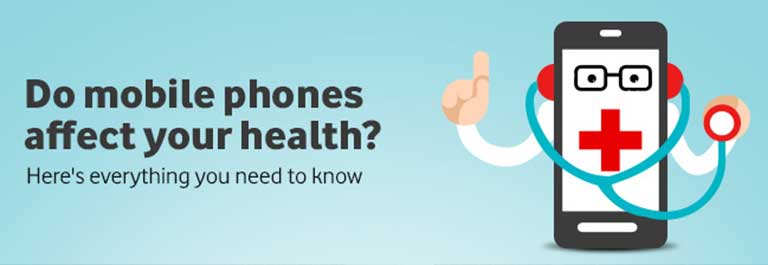Mobiles and Health
FAQs on mobiles and health
We designed this website to provide straightforward information about mobile phones, towers and health for customers and the public. If you couldn't find what you were looking for, these commonly asked questions may help.
Are mobile phones and towers safe?
There is no convincing evidence that the use of mobile phones and the towers that make them work carry health risks, when they are operated within the guideline limits set by the International Commission on Non-Ionizing Radiation Protection (ICNIRP). The World Health Organization (WHO) supports this position.
More specifically, experts see the possibility of health effects from living or working near a base station as extremely low. The WHO fact sheet Base stations and wireless technologies, published in 2006, concludes that "considering the very low exposure levels and research results collected to date, there is no convincing scientific evidence that the weak radiofrequency signals from base stations and wireless networks cause adverse health effects".
In India, the government has, further reduced the exposure limits from base stations which are one-tenth the ICNIRP guidelines making the Indian EMF exposure limits amongst the strictest in the world. As the ICNIRP limits already included a 50 times reduction/safety factor, the lowering of the EMF limits for Base Stations to one-tenth of ICNIRP has added a further margin of safety.
Why do we need towers?
Mobile phones use radio frequency (RF) fields to send and receive calls and data via the nearest base station (often called towers or antennas). Many other everyday items also use RF fields to send and receive information, such as television &, radio broadcasting and two-way radio communications.
Mobile phones won't work without a network of base stations to connect them. Each base station only covers a certain area and can only handle a limited number of calls at once, and so a large number are needed for more people to use mobile phones, from more locations, and for coverage to be continuous when moving around. We expand our mobile network to ensure we continue to meet customer demand.
If the scientific evidence says phones and towers are safe, why are there still high levels of public concern?
While, the majority of experts say there is no scientific reason to distance base stations from places where people live and work, we recognise that some people are concerned about potential health effects of mobile phones and base stations, and about the installation of base stations in various locations.
In fact it was to allay these concerns that the Government of India has reduced the EMF exposure limits from base stations to one-tenth of the ICNIRP limits. As the ICNIRP limits already carry a 50 times reduction/safety factor, the further 90% reduction in the limits by the Indian Government add a further safety margin, making the limits even more protective for all people at all locations.
We are also committed to understanding and addressing these concerns. Our effort is to track and review all public developments about mobile phones and towers and provide a range of useful information to our consumers who are concerned about potential health effects. We hope that this information provided by us will help allay public concerns.
What if I am still concerned?
People concerned about the health effects of mobile phones or base stations may find the World Health Organization's (WHO) guidance helpful. It is pertinent to note that the WHO's research agenda does not include further studies into the effects of RF exposure from base stations. WHO in its above fact sheet has stated “While no health effects are expected from exposure to RF fields from base stations and wireless networks, research is still being promoted by WHO to determine whether there are any health consequences from the higher RF exposures from mobile phones.”
Also, the WHO provides information on how to effectively reduce mobile device exposure:
"In addition to using "hands-free" phones, which keep mobile phones away from the head and body during phone calls, exposure is also reduced by limiting the number and length of calls. Using the phone in areas of good reception also decreases exposure as it allows the phone to transmit at reduced power."
(WHO Fact Sheet 193 May 2010 - Electromagnetic fields and public health: mobile phones).
What is Vi™ doing to address the public's concerns?
While, the majority of experts say there is no scientific reason to distance base stations from places where people live and work, we recognise that some people are concerned about potential health effects of mobile phones and base stations, and about the installation of base stations in various locations.
In fact it was to allay these concerns that the Government of India has reduced the EMF exposure limits from base stations to one-tenth of the ICNIRP limits. As the ICNIRP limits already carry a 50 times reduction/safety factor, the further 90% reduction in the limits by the Indian Government add a further safety margin, making the limits even more protective for all people at all locations.
We are also committed to understanding and addressing these concerns.. Our effort is to track and review all public developments about mobile phones and towers and provide a range of useful information to our consumers who are concerned about potential health effects. We hope that this information provided by us will help allay public concerns.
Are children more susceptible to EMF exposure?
The UK Independent Advisory Group on Non-Ionizing Radiation (AGNIR) studied health effects from radiofrequency electromagnetic fields and has in its 2012 report concluded that "In summary, although a substantial amount of research has been conducted in this area, there is no convincing evidence that RF field exposure below guideline levels causes health effects in adults or children."
http://www.hpa.org.uk/webw/HPAweb&HPAwebStandard/HPAweb_C/1317133826368
It may be noted that as per WHO, while no health effects are expected from exposure to RF fields from base stations and wireless networks, research is still being promoted by WHO to determine whether there are any health consequences from the higher RF exposures from mobile phones.
Furthermore the EMF exposure guidelines set out by ICNIRP are intended to be protective of children as well as adults. We aim to give parents the knowledge they need to make an informed decision regarding their child's mobile device use. They may choose to balance their children's access to and use of mobile phones with the security benefits.
Is exposure greater from a mobile device or a base station?
A typical handset may operate at a maximum of 0.25 watts and a base station generally between 2–20 watts per sector, so the power from the base station is greater. However, exposure decreases rapidly with distance, so exposure from the mobile device is greater because it is closer to the body – although still well within guideline levels.
As per WHO, recent surveys have indicated that RF exposures from base stations in publicly accessible areas (including schools and hospitals) are normally thousands of times below international standards.
What exactly are the emissions from mobile phones and towers?
Mobile phones and base stations use radiofrequency (RF) fields to send and receive calls and data. RF fields are a form of low-energy electromagnetic field (EMF) – energy transmitted as waves through space. EMFs surround us all the time. They occur naturally as well as from artificial sources.
EMFs are created whenever an electric current flows. In nature, they are created by lightning and also occur in the human nervous system. Light from the sun is a form of EMF. They are also created whenever an electrical appliance is connected to the mains supply, including many in daily use such as refrigerators, hairdryers and computers.
Many electrical appliances don't just create EMF – they rely on it to work. Television, radio, cordless phones, remote control handsets, baby monitors and the communication systems used by emergency services all communicate using EMF. So do wireless technologies such as WiFi, which is increasingly used by computer networks, to connect to the internet and to connect different electronic items.
There are many forms of EMF operating at different frequencies. Frequency is related to wavelength – the distance between one wave and the next. The closer together the waves are, the higher the frequency will be.
Some very short electromagnetic wavelengths carry so much energy they can cause molecules to change. Examples include the x-rays used for medical diagnosis and radiotherapy treatment. These are known as ionising fields. Other wavelengths, such as those used by mobile phones and base stations, do not have enough energy to cause molecules to change. These are non-ionising fields. All types of EMF fall into these two categories.
What is SAR value?
SAR stands for specific absorption rate, which is the standard way of measuring exposure to radiofrequency (RF) fields from mobile phones. It measures the amount of energy from an RF field that the human body absorbs. The maximum SAR value, as established under standard test conditions, for each mobile device is provided in the user guide. Many manufacturers also make this information available on their own website or the Mobile Manufacturers Forum website. The exposure (SAR) at any given time depends on may factors including the distance from the base station, the operating frequency band, the service the mobile phone is used for and other factors.
Is it safe to carry a mobile device close to your body?
There is no evidence to suggest that holding a mobile device close to your body has any harmful effect, provided the device meets the recommended ICNIRP (International Commission on Non-Ionizing Radiation Protection) guidelines.
How long is it safe to use a mobile device for?
In its fact sheet Mobile phones and their base stations, the World Health Organization (WHO) states there is no need for any special precautions when using a mobile device, because the radiofrequency fields people are exposed to are below the limits for continuous exposure of the general public specified by the International Commission on Non-Ionizing Radiation Protection (ICNIRP).
However, we want to provide those concerned with useful information. People who personally want to can take simple steps to reduce their exposure:
When in use, keep the mobile device away from the head and body by:
- Using an earpiece (wired or Bluetooth)
- Using the loudspeaker function (including video calls)
- Placing the device on a surface when sending data files.
- Texting instead of calling.
Will towers and mobile phones still be safe in the future as well?
Mobile technology is expanding all the time and many items now use RF fields to provide a wireless connection, such as laptop and handheld computers and access points for mobiles phones and broadband. The ICNIRP (International Commission on Non-Ionizing Radiation Protection) guidelines cover these and future technologies as well as mobile phones and base stations. Our policies and commitments on mobile phones, towers and health also apply to new wireless technologies.
We review the findings of research into RF fields taking place around the world and take the advice of recognised expert scientific review panels and health authorities on mobile phones, towers and health. We will consider new research findings to be significant if one of these panels or authorities advises that the findings change the overall weight of scientific evidence, and changes its position accordingly.


